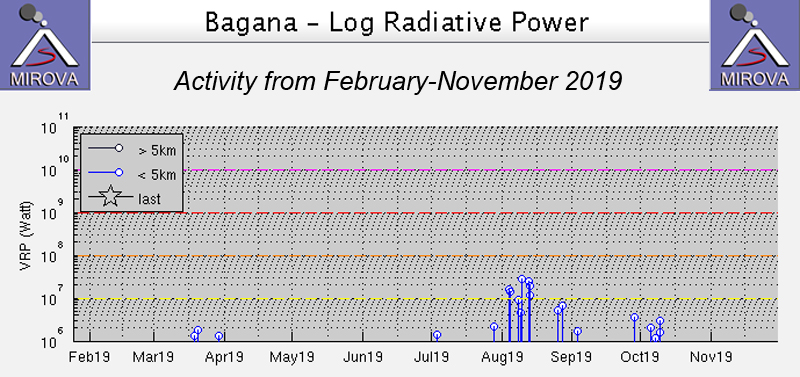Report on Bagana (Papua New Guinea) — December 2019
Bulletin of the Global Volcanism Network, vol. 44, no. 12 (December 2019)
Managing Editor: Edward Venzke.
Edited by Kadie L. Bennis.
Bagana (Papua New Guinea) Intermittent gas-and-steam emissions and thermal anomalies during June-November 2019
Please cite this report as:
Global Volcanism Program, 2019. Report on Bagana (Papua New Guinea) (Bennis, K.L., and Venzke, E., eds.). Bulletin of the Global Volcanism Network, 44:12. Smithsonian Institution. https://doi.org/10.5479/si.GVP.BGVN201912-255020
Bagana
Papua New Guinea
6.137°S, 155.196°E; summit elev. 1855 m
All times are local (unless otherwise noted)
Bagana volcano is found in a remote portion of central Bougainville Island in Papua New Guinea. The most recent eruptive phase that began in early 2000 has produced ash plumes and thermal anomalies (BGVN 44:06, 50:01). Activity has remained low between January-July 2019 with rare thermal anomalies and occasional steam plumes. This reporting period updates information for June-November 2019 and includes thermal anomalies and intermittent gas-and-steam emissions. Thermal data and satellite imagery are the primary sources of information for this report.
MIROVA (Middle InfraRed Observation of Volcanic Activity) analysis of MODIS satellite data showed an increased number of thermal anomalies within 5 km from the summit beginning in late July-early August (figure 30). Two Sentinel-2 thermal satellite images showed faint, roughly linear thermal anomalies, indicative of lava flows trending EW and NS on 7 July 2019 and 6 August, respectively (figure 31). Weak thermal hotspots were briefly detected in late September-early October after a short hiatus in September. No thermal anomalies were recorded in Sentinel-2 past August due to cloud cover; however, gas-and-steam emissions were visible on 7 July and in September (figures 31, 32, and 33).
 |
Figure 32. A gas-and-steam plume rising from the summit of Bagana on 18 September 2019. Courtesy of Brendan McCormick Kilbride (University of Manchester). |
The Deep Carbon Observatory (DCO) scientific team partnered with the Rabaul Volcano Observatory and the Bougainville Disaster Office to observe activity at Bagana and collect gas data using drone technology during two weeks of field work in mid-September 2019. For this field work, the major focus was to understand the composition of the volcanic gas emitted at Bagana and measure the concentration of these gases. Since Bagana is remote and difficult to climb, research about its gas emissions has been limited. The recent advancements in drone technology has allowed for new data collection at the summit of Bagana (figure 33). Most of the emissions consisted of water vapor, according to Brendan McCormick Kilbride, one of the volcanologists on this trip. During 14-19 September there was consistently a strong gas-and-steam plume from Bagana (figure 34).
 |
Figure 34. Photos of gas-and-steam plumes rising from Bagana between 14-19 September 2019. Courtesy of Brendan McCormick Kilbride (University of Manchester). |
Geological Summary. Bagana volcano, in a remote portion of central Bougainville Island, is frequently active. This massive symmetrical cone was largely constructed by an accumulation of viscous andesitic lava flows. The entire edifice could have been constructed in about 300 years at its present rate of lava production. Eruptive activity is characterized by non-explosive effusion of viscous lava that maintains a small lava dome in the summit crater, although occasional explosive activity produces pyroclastic flows. Lava flows with tongue-shaped lobes up to 50 m thick and prominent levees descend the flanks on all sides.
Information Contacts: MIROVA (Middle InfraRed Observation of Volcanic Activity), a collaborative project between the Universities of Turin and Florence (Italy) supported by the Centre for Volcanic Risk of the Italian Civil Protection Department (URL: http://www.mirovaweb.it/); Sentinel Hub Playground (URL: https://www.sentinel-hub.com/explore/sentinel-playground); Brendan McCormick Kilbride, University of Manchester, Manchester M13 9PL, United Kingdom (URL: https://www.research.manchester.ac.uk/portal/brendan.mccormickkilbride.html, Twitter: https://twitter.com/BrendanVolc); Kieran Wood, University of Bristol, Bristol BS8 1QU, United Kingdom (URL: http://www.bristol.ac.uk/engineering/people/kieran-t-wood/index.html, Twitter: https://twitter.com/DrKieranWood, video posted at https://www.youtube.com/watch?v=A7Hx645v0eU); University of Bristol Flight Laboratory, Bristol BS8 1QU, United Kingdom (Twitter: https://twitter.com/UOBFlightLab).




